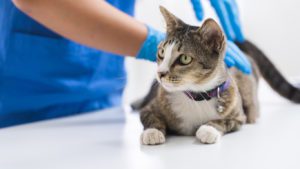Everything You Need to Know About Cat Ringworm in Mishawaka, IN
If someone says your cat may have ringworm, you might think your pet has parasites. But that isn’t the case. Despite the name, ringworm isn’t a parasite. It’s actually a skin fungal infection, also known as dermatophytosis.
According to the Merck Veterinary Manual, “In cats, about 98% of ringworm cases are caused by the fungus Microsporum canis.” And worldwide, it’s one of the most common, and highly contagious, feline skin disorders.
This article will help you learn about ringworm and what to do if your cat becomes infected with it.

Should I Be Concerned About Ringworm?
A ringworm infection shouldn’t be taken lightly.
Ringworm is a condition all cat owners should be familiar with, watch for, and know what to do if an infection is suspected. Even though it may go away on its own, it will take from nine months to one year. And all the while, the cat’s hair will keep falling out and leaving bare skin. This opens the cat to the danger of skin wounds and other infection.
How Do Cats Get Ringworm?
With the highly contagious nature of ringworm, it’s no surprise that infection is easily passed between cats. Though healthy felines are more likely to come into contact with the fungus without becoming infected than compromised cats.
Risk factors for ringworm include:
- Compromised immune system
- Skin injury
- Less than two years old
- Elderly
- Malnourished
- Stressed
- Infested with fleas
- Long haired
- Cats in large populations
This fungus is naturally present in soil which makes it almost impossible to avoid. But that isn’t the only way your pet can come into contact with ringworm.
Infected wild rodents can bring it into your home. And it can be transported indoors on clothing or animal hair. Once inside, the fungal spores can live just about anywhere and they can survive for up to 18 months.
Yet, despite the easy transfer of spores, it doesn’t mean a pet will contract the infection. Spores may simply be cleaned away by a cat through normal grooming with no adverse issues.
How is Ringworm Confirmed?
From the time of exposure, incubation of the ringworm fungus and development of lesions, ranges from one to two weeks. Though sometimes it may take up to three weeks before signs of infection develop. If ringworm is suspected, your veterinarian will try to rule out other dermatologic conditions first.
Ringworm can be diagnosed by a fungal culture of hair or a skin scrape from an affected area. Fungal cultures are the most accurate way to determine if ringworm is present. But this isn’t a quick diagnosis. It can take up to 21 days to get results.
A veterinarian can also get a positive result, though it isn’t the best test, by using an ultraviolet light. Hair contaminated with fungus will glow yellowish-green under ultraviolet lighting. This kind of test will still need verification with a culture.

How to Know if Your Cat has Ringworm?
The main places lesions show up are on the cat’s face, head, ears (tips), chest, along the back, forelegs, feet, and tail. Occasionally, onychomycosis, infection of the claws, will also occur. When this happens, the claws become pitted, rough, and possibly deformed. Sometimes a larger area of the cat’s body is affected, as noted by patches of hair loss. It’s possible that some cats, especially breeds with long hair, may have ringworm but no clinical signs. These are asymptomatic carriers. These cats may infect other felines without owners being aware of an infection.
Signs of infection:
- Circular, reddish, scaly, crusted patches.
- Thickened skin.
- Bald patches or hair that becomes stubby or dull.
- Small, itchy bumps.
- Excessive scratching and grooming. (Though itching and scratching isn’t always present.)
- Cats with widespread infection can also have open sores and bigger bumps.
What does Ringworm Treatment involve?
It’s possible that ringworm will resolve on its own. But treatment will clear it up quicker. And since it’s contagious, you’ll want to take care of it as soon as possible. Your veterinarian may prescribe anti-fungal medications (shampoo, dip, spray) but these aren’t always effective.
If the infection is widespread, your cat may need oral antifungal medication. Or a combination of topical and oral treatment. Sometimes a cat will need to be shaved if infection is extensive or if the cat has long hair. In especially bad cases, treatment can take weeks or months. This is even more reason to get help for your cat as soon as possible. In any case, your cat will generally need treatment until two (consecutive) ringworm cultures are negative.
If you have more than one pet, sometimes your veterinarian may recommend treating all of the animals in your household. Regardless, you should keep all infected animals separated from healthy animals to curb spreading the infection and to help with the cleaning process necessary to decontaminate your home.
Once aggressive treatment begins, infected animals will still be contagious for about three weeks. If only minimal treatment is given or you don’t follow the prescribed approach as instructed, the infection will last longer and the contagious period will be extended.
During the first week or so of treatment the lesions might not change much. But some improvement should be seen within two or three weeks. However, if treatment isn’t aggressive enough or it’s discontinued too soon, symptoms may recur. In the case of recurring symptoms, your veterinarian may have to pivot and try other medications.
Can cats pass ringworm infection to people?
The short answer is yes. Ringworm is a zoonotic disease, meaning animals can give it to human beings. Infection happens through direct contact between an animal and a human. However, healthy adults are usually resistant unless they have a compromised immune system or broken skin that allows transmission to occur. Children and the elderly are at greater risk for catching ringworm from a pet than healthy young to middle-age adults.
When a human is infected, the body or scalp can be affected and result in red, itchy, scaly skin, and bald patches in the scalp or beard. The infection can be passed directly between people from skin contact or through contaminated items, such as clothing, personal items (hair brush), or even by sharing showering facilities. On the flip side, it is also possible for an infected person to transmit the virus to their pet.
Can your cat infect pets other than felines in your home?
Again, the short answer is yes. Ringworm commonly affects dogs as well as cats. If you have a cat with ringworm and you also have a dog, it may be passed easily from the cat to your dog. It can also spread to pet rabbits, pet rodents, and other mammals.
What if your home is infested with contamination?
Preventing contamination indoors is almost impossible. And you’ll have to be thorough to get rid of as many spores as possible. You’ll never get rid of all of them but that isn’t the goal. You want to decontaminate as much as you can though. You won’t be able to clean everything in a couple of days. Just keep at it until you have cleaned everything and everywhere spores can hide. You’ll want to keep cleaning as long as your cat still has an infection.
You’ll want to begin clean up as soon as you suspect your cat is infected. Don’t wait for your veterinarian to confirm ringworm to start the cleaning process. If possible, try to limit your cat’s access to certain parts of your home, until the veterinarian confirms the virus is cleared. But keep in mind that confining a cat can cause stress which isn’t helpful.
Launder fabric, small area rugs, and other small washable items that may have come into contact with spores. Disinfect solid surfaces. Do not use a broom to clean floors. Brooms are nearly impossible to decontaminate. Clean tile and hardwood with a damp cloth. A Swiffer will work. Dispose of the soiled pads when done. Vacuum carpeting, drapes, and upholstery. Throw away the vacuum bag. Commercial steam cleaning works best but avoid disinfectants as you risk discoloring the carpet. All textiles will need to be cleaned. And you’ll want a good vacuum cleaner, not a cheap one that might blow some spores back out.
Consider putting sheets over cleaned furniture to keep spores off until the infection is eradicated. Change furnace and air filters. Remove or launder any bedding used by the cat and toss out any brushes used on the infected cat. Replace or scour feeding and watering bowls. Don’t forget to clean cat trees, pet carriers, and toys.

Conclusion
Because ringworm is highly transmissible between cats, humans, dogs and other pets, it’s important to recognize this infection as soon as possible and immediately seek veterinary help in eliminating it.
Just as important is a thorough cleaning of your home and any items that could harbor the virus. Even though healthy pets and people may not become infected, it’s still possible to transport spores from place to place where another pet or person could become effected.
Ringworm can seem nearly impossible to beat, but it isn’t. Follow your veterinarian’s directives and start cleaning. The sooner you take action, the sooner you will beat ringworm. If you suspect your cat has ringworm please give us a call at (574) 256-1871 or Request an Appointment.

